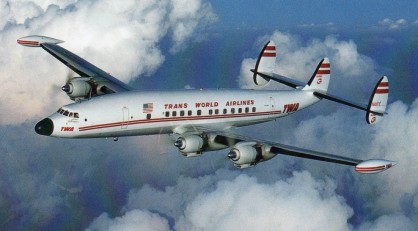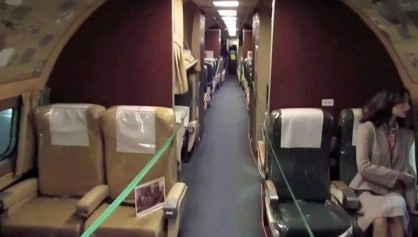“CONNIE”
November 21, 2015
One of the most gifted engineers in our nation’s history was Mr. Bill Lear. Lear was born in Hannibal, Missouri on 26 June 1902 and over a forty-six (46) year time period produced one hundred and twenty (120) patents. He founded the LearJet Corporation. The Lear jet is without doubt one of the most beautiful aircraft ever conceived. From one memorable life came one memorable quote, as follows:
“If an airplane looks like it will fly—it will fly”.
He was talking about profile, lines, curvature while imagining the “slip-stream” created by the leading edges and the flight surfaces. One other airplane that fits that description is the Lockheed Constellation or “Connie” as the design came to be known. A remarkably beautiful aircraft.
My very first flight was in 1969. My father, sister and I departed Lovell Field in Chattanooga, Tennessee heading to Atlanta. We flew to Atlanta in a DC-3, twin engine propeller-driven aircraft. (I’m sure after death I will have to change planes in Atlanta before arriving in heaven. Some things never change.) Moving from arrival gate to departure gate during the very early years of commercial aviation took a minimal amount of time. The Atlanta Hartsfield-Jackson International Airport was not the city within a city that exists today. Upon arriving at our departure gate, I saw for the very first time a marvelous aircraft meeting all of the descriptive points Mr. Lear had in mind. Let’s take a look.
LOCKHEED CONSTELLATION:
The Lockheed Constellation (“Connie”) was a propeller-driven, four-engine airliner built by the Lockheed Corporation between 1943 and 1958 at the Burbank, California Lockheed facilities. The Constellation’s fuselage is shaped like an airfoil to add lift. It curves upward at the rear to raise the triple tail out of the prop wash and slightly downward at the front so the nose-gear strut did not have to be impossibly long. Lockheed decided that the airplane’s admittedly large propellers needed even more ground clearance than did Douglas or Boeing on their competing transports, which resulted in the Connie’s long, spindly gear legs.
It was known as “the world’s best tri-motor” because it had so many engine failures it often flew on three. There were large numbers of engine fires during the Constellation’s early development, but many airline pilots flew it for years without ever feathering an engine.
The Constellation was one of the first pressurized airliners with the Boeing 307 Stratoliner being the very first. Cabin pressurization was absolutely required to improve the service ceiling of commercial aircraft and make flying above the “weather” a very welcome reality. During WWII it was discovered that flying about 10,000 feet required oxygen to preclude issues with dizziness. It was no different for commercial flying.
Lockheed built 856 aircraft using numerous model configurations—all with the same triple-tail design and dolphin-shaped fuselage. Most were powered by four 18-cylinder Wright R-3350s. The Constellation was used as a civil airliner and as a military and civil air transport, seeing service in the Berlin Airlift . It was also the presidential aircraft for Dwight D. Eisenhower. At the present time President Eisenhower’s Air Force One is resting in a field at Marana Regional Airport. Dubbed Columbine II in honor of the state flower of first lady Mamie Eisenhower’s native Colorado, the plane was state-of-the-art in its time. It’s a real shame this early version of Air Force One is not on display.
The Constellation’s wing design was close to that of the P-38 Lightning, differing obviously in size. The triple tail kept the aircraft’s height low enough to fit in existing hangars, while features included hydraulically boosted controls and a de-icing system used on wing and tail leading edges. The aircraft had a maximum speed of over 375 mph (600 km/h), faster than that of a Japanese Zero fighter, a cruise speed of 340 mph (550 km/h), and a service ceiling of 24,000 ft (7,300 m). At the time the service ceiling was a significant breakthrough in aviation technology.
According to Anthony Sampson in Empires of the Sky, Lockheed’s Skunk Factory and Kelly Johnson may have undertaken the intricate design, but Howard Hughes’ intercession in the design process drove the concept, shape, capabilities, appearance, and ethos. These rumors were discredited by Kelly Johnson. Howard Hughes and Jack Frye confirmed that the rumors were not true in a letter in November 1941.
After World War II the Constellation came into its own as a very fast civil airliner. Aircraft already in production for the USAAF as C-69 transports were finished as civil airliners, with TWA receiving the first on 1 October 1945. TWA’s first transatlantic proving flight departed Washington, DC, on December 3, 1945, arriving in Paris on December 4 via Gander, Nova Scotia and Shannon, Ireland.
Trans World Airlines transatlantic service started on February 6, 1946 with a New York-Paris flight in a Constellation. On June 17, 1947 Pan American World Airways opened the first ever scheduled round-the-world service with their L-749 Clipper America. The famous flight “Pan Am 1” operated until 1982.
As the first pressurized airliner in widespread use, the Constellation helped to usher in affordable and comfortable air travel. Operators of Constellations included the following airlines:
- TWA
- Eastern Air Lines
- Pan American World Airways
- Air France
- BOAC
- KLM
- Qantas
- Lufthansa
- Iberia Airlines
- Panair do Brasil
- TAP Portugal
- Trans-Canada Air Lines(later renamed Air Canada)
- Aer Lingus
- VARIG
- Cubana de Aviación
- Línea Aeropostal Venezolana.
CABIN:
For its time, the cabin represented the ultimate in luxury with comfort and room to spare.
Maybe someone can comment on a statement I have heard more than once. In the early days of commercial aviation, all of the cabin crew had to be registered nurses. Do you know if that is a fact?
COCKPIT:
Notice from the digital below, all of the flight systems were analogue. No digital in those days. Also notice, the aircraft was meant to be managed by a three-man flight crew; i.e. pilot-in-command, co-pilot and flight engineer or navigator. The right side of the cockpit was designed for a navigator.
Two fairly large fans, one left and one right, kept the flight crew reasonably comfortable.
Times have certainly changed from my first flight in 1969. No more analogue or two-man flight crew and now air travel is the “new” Greyhound. It’s affordable, at least to some degree.
As always, I welcome your comments.






